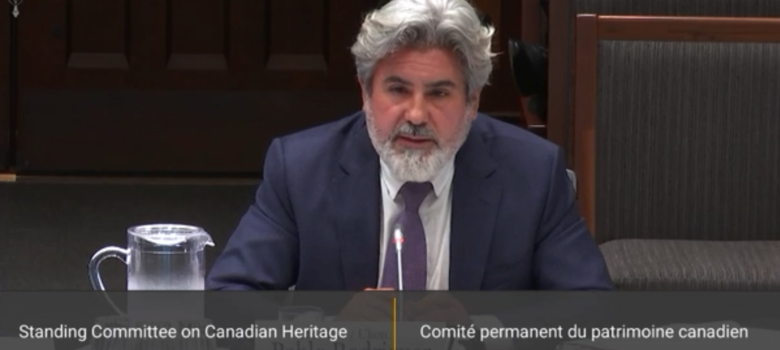Canadian Heritage Minister Pablo Rodriguez appeared before the Standing Committee on Canadian Heritage yesterday, using the opportunity to defend Bill C-11 with assurances that concerns about the inclusion of user content within the bill were “unfounded.” As this post unpacks, the denials of content regulation ring hollow as his defence falls apart on close examination of the bill. Numerous witnesses, including digital creators, Internet platforms, and industry associations, have all expressed concerns about the issue. Rather than respond to them, Rodriguez and the government implausibly deny that the issue exists at all.
Rodriguez relied on at least three claims yesterday with respect to user content. First, he simply contradicted his own CRTC chair, stating that Bill C-11 does not regulate user content. In fact, Rodriguez was asked directly by Liberal MP Anthony Housefather about the issue:
Housefather: When it comes to Section 4.2, we’ve heard a lot of comments again about what is regulated or what is not regulated. Can you clarify again that content is not regulated?
Rodriguez: Absolutely. It is not.
As the video below makes clear, Rodriguez’s claim is inconsistent with what CRTC Chair Ian Scott told the same committee just last week:
[Section] 4.2 allows the CRTC to prescribe by regulation user uploaded content subject to very explicit criteria. That is also in the Act.
The government’s continued insistence that the bill does not do what it plainly does seems like a classic case of gaslighting. But Rodriguez doesn’t stop there. He relies yet again on the claim that “platforms are in, users are out.” While this is true in the sense that users are not regulated like platforms due to an exception in the bill, the truth is the bill regulates indirectly what it cannot do directly. In other words, users may not be called before the CRTC, but their content falls under CRTC regulation with platforms tasked with the enforcement. Both Youtube and Tiktok, the two best-known user content platforms, have provided the committee with submissions that make it clear that as currently structured platforms and user content both face regulation with Bill C-11.
Third, Rodriguez also emphasized that the bill was limited to “commercial” user content, noting that there are three criteria for the CRTC to consider whether the content falls within the ambit of the Act. The Minister referred to content that generates revenue and was asked repeatedly how much revenue is needed in order to qualify. As this lengthy exchange demonstrates, he refused to provide actual number, instead stating that there was no threshold and that the CRTC would consider all the criteria.
The criteria in the bill are:
- whether the program that is uploaded to a social media service directly or indirectly generates revenue
- if the program has been broadcast by a broadcast undertaking that is either licensed or registered with the CRTC
- if the program has been assigned a unique identifier under an international standards system
Rodriguez sought to leave the impression that these criteria limit the scope of regulation on user content, but the TikTok submission notes that its interpretation is that any TikTok video that uses music would qualify:
On TikTok, users can include short clips – typically no more than 30 seconds long – of popular music in the background of their videos. To illustrate how broadly Section 4.2 could be interpreted, take the example of a Canadian TikTok creator who posts a dance video using Ucluelet, BC, singer Jessia’s song, I’m Not Pretty. Even though it’s only a 30- second clip of the music, that video would still meet all criteria of Section 4.2:
1. The video/song is monetized: TikTok indirectly monetizes all videos on our platform by interspersing ads in a user’s feed. This video would be further monetized by the royalties that TikTok would pay to Jessia (or the track’s rightsholder) for use of the clip.
2. The song appears on a regulated platform: I’m Not Pretty is available on streaming platforms (like Spotify or Apple Music) and on the radio.
3. The song has a unique identifier code: I’m Not Pretty has multiple codes associated with it, including an ISRC for the performance and an ISWC for the underlying work.
This same analysis would apply to uses of short clips of a TV show or movie in a TikTok video, such as a user posting a reaction video to a funny clip from an episode of Schitt’s Creek. It would also apply to users posting their own amateur cover performances of their favourite songs, as the bill doesn’t differentiate between the performance and the underlying work. To be clear, this means any video on TikTok that uses music could be subject to regulation under the Broadcasting Act.
Similar analysis can be applied to many Youtube videos, podcasts, and the content created by Canadians. Rodriguez keeps insisting that this content falls outside the bill, while those directly affected – as well as those tasked with establishing and enforcing regulations – say otherwise. Given the evidence, the Minister’s denials ring hollow.










Wondering about consequences for fan videos, whatever the fandom, whether it’s fan fiction or fan commentaries…and guessing that the consequences are not meant to be pleasant.
One thing I’m having trouble following is what the significance of the bill applying/not applying to someone’s content is.
If I make a youtube video, through some three ingredient alchemy the CRTC will determine if it’s commercial or not. From there, they would determine whether or not it is Canadian. Therefore, there will be three types of content: Non commercial, commercial canadian, and commercial non-canadian. NonComCon, ComCanCon, and ComNonCanCon, respectively. The fourth possible content type, The Necronomicon, is not discussed in the bill (for good reason).
But the bill privileges ComCanCon and treats NonComCon the same as ComNonCanCon, right? So the bill “not applying” to my video is essentially the same as the bill applying to my video but my video not being Canadian enough.
Am I wrong here? It seems to me that having my content be exempt from this bill is, if anything, a disadvantage. The bill is written to give advantage to certain content, so the victims are those to whom it *does not* apply.
Am I wrong here?
You are correct. People who already tick all the boxes and has the resources or connections to ensure they do (legacy media) stands to gain as a result.
Pingback: Heritage Minister Contradicts CRTC Chair on Bill C-11 User Content, Accuses Tories of ‘Misinformation’ - True USA
Pingback: Heritage Minister contradicts CRTC chairman on bill C-11 user content and accuses Tories of “misinformation” – Trend News – Securykid
Of course, this situation may seem ambiguous and cause different reactions, but, quite frankly, I don’t understand the policy of Canadian Heritage Minister Pablo Rodriguez because I think that his position is absolutely unreasonable and it is not backed up with the substantial arguments. From my point of view, he is guided by the wrong approach, acting in a wrong way, because his denials and categorical judgments will not bear necessary fruits. I think that he needs to look at the bill from a different angle and change his attitude to it, seeing a real state of affairs. I can’t really understand the goal of his actions and what he wants to achieve, but it is irrational anyway. I think that everything needs to stay the same and not to undergo changes because it will not lead to global positive consequences, but can only harm in some respects.
Pingback: Jesse Kline: C-11 will allow Liberals to control all that you see and hear online - National Post - YouTube Money Makers